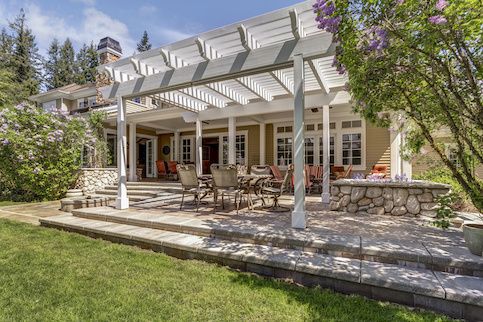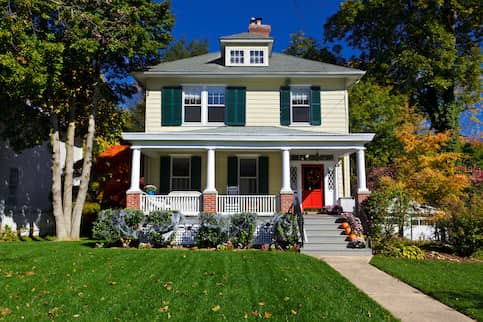Interest rates fluctuate quite a bit. When buying a house costs hundreds of thousands of dollars, even the smallest movement in interest rates can affect your mortgage payment and lifetime loan costs substantially. A float-down option could allow you to lock your rate and be protected from rising costs while also giving the flexibility to take advantage of a rate drop.
What Is A Float-Down Option?
A float-down option allows borrowers to take advantage of a lower rate even if they had previously locked theirs if rates drop before closing on their mortgage. Since interest rates fluctuate often, a float-down rate is one way home buyers can save during the search.
Lenders typically have rules around the timing of your float-down option. We’ll go over some of the most common program structures, but be sure to speak to your specific lender for details.
See What You Qualify For
Buy A Home
Discover mortgage options that fit your unique financial needs.

Refinance
Refinance your mortgage to have more money for what matters.
Tap Into Equity
Use your home’s equity and unlock cash to achieve your goals.
How Do Float-Down Options Work?
The key to a float-down option is that you have the ability to lock your mortgage rate while you’re shopping for your home to protect yourself from interest rates pushing higher. Typically, it’s a one-time option to move down to a lower rate if mortgage rates oblige.
Let’s say you’re getting a 30-year mortgage for $250,000. You might initially lock your rate at 6.5%. If rates drop by just 0.25% over the time you’re shopping, locking in the lower rate would save you almost $41 per month on your payment. Additionally, you would be saving $14,715.74 in interest.
You’ll often have a period of time when you can shop for a home and time to close on your home prior to your rate lock expiring. You can float down during the shopping period. Once you find a home, the underwriter will need to know your final interest rate to complete last qualification checks based on what the payment would be.
Rate Lock Vs. Float-Down Rate
A float-down rate is a type of rate lock. Under a traditional rate lock, you can’t decide to lock your rate until after you have a signed purchase agreement, meaning you you’ve already found a house. This is intended to give you the option to protect your rate while arranging for an appraisal and home inspection as well as title and homeowners insurance.
With a float-down option, you can lock your rate while you shop with a limited option to take a lower rate if rates fall further. All rate locks are time-limited and float-down locks are no different, but the time frame tends to be longer. If you would usually lock for 30 days, a float-down rate could mean 90 days to shop with additional time to complete the process on finding a house.
Home Buyer’s Guide
Follow our step-by-step guide to learn how to buy a home.
Pros And Cons Of Getting A Mortgage Float-Down
There are both benefits and things you should be aware of when getting a float-down rate.
Pros
- Rate can only get better: As with any rate lock, you’re protecting yourself from rates moving higher. But a float-down option also gives you the bonus flexibility of being able to move down to a lower rate if the market moves in your favor.
- Lock earlier: With a float-down rate, you can typically lock your rate while shopping for a home. With a traditional rate lock, you have to find a house and have a signed purchase agreement in place.
- Additional time to complete the process: Once you’ve found a home, you’ll have additional time to get through the underwriting, appraisal and home inspection process.
Cons
- Fewer product options: Lenders often only offer float-down rates on certain product options.
- Higher mortgage points: When you lock your rate, lenders have to hedge against the market in order to protect themselves from adverse market movements. The longer your lock period, the harder this is. So it’s not uncommon to pay a higher fee to lock your rate with a float-down option.
Alternatives To A Float-Down Option
If getting a float-down rate is impossible or impractical for you at this time, there are a couple of alternatives you could consider.
- Adjustable-rate mortgage (ARM): An ARM loan features a little lower initial rate than the market rate for fixed mortgages with comparable terms. Depending on the option you qualify for, this typically lasts for the first 5, 7 or 10 years of the loan. Of course, the rate could always increase after this, but there are caps. Also, some people take advantage of the lower payment at the beginning of the loan to put extra money toward the principal balance, so by the time the rate adjusts, they’re paying on a lower balance anyway. Additionally, if you maintain enough equity and qualify, you might also be able to refinance. Finally, many in starter homes might choose to move to their next home and sell the current one before the rate ever adjusts.
- Refinance: If an ARM doesn’t make sense for you, it’s important to note that you aren’t tied into one mortgage rate for as long as you live in your house if you don’t want to be. Even if you get a fixed rate, you can always consider refinancing down the line if rates drop as long as you qualify.
The Bottom Line
A float-down option allows you to lock your interest rate to protect yourself from higher interest rates before you close. And you still have the option to move to a lower rate if the market turns in your favor.
It’s important to be clear with your lender about the exact terms of any float-down option and to understand any fees associated. If a float-down is unavailable or doesn’t make sense for your situation, you can always look at an ARM or refinancing down the line.
Find A Mortgage Today and Lock In Your Rate!
Get matched with a lender that will work for your financial situation.

Kevin Graham
Kevin Graham is a Senior Writer for Rocket Companies. He specializes in economics, mortgage qualification and personal finance topics. As someone with cerebral palsy spastic quadriplegia that requires the use of a wheelchair, he also takes on articles around modifying your home for physical challenges and smart home tech. Kevin has a bachelor's degree in journalism from Oakland University.












